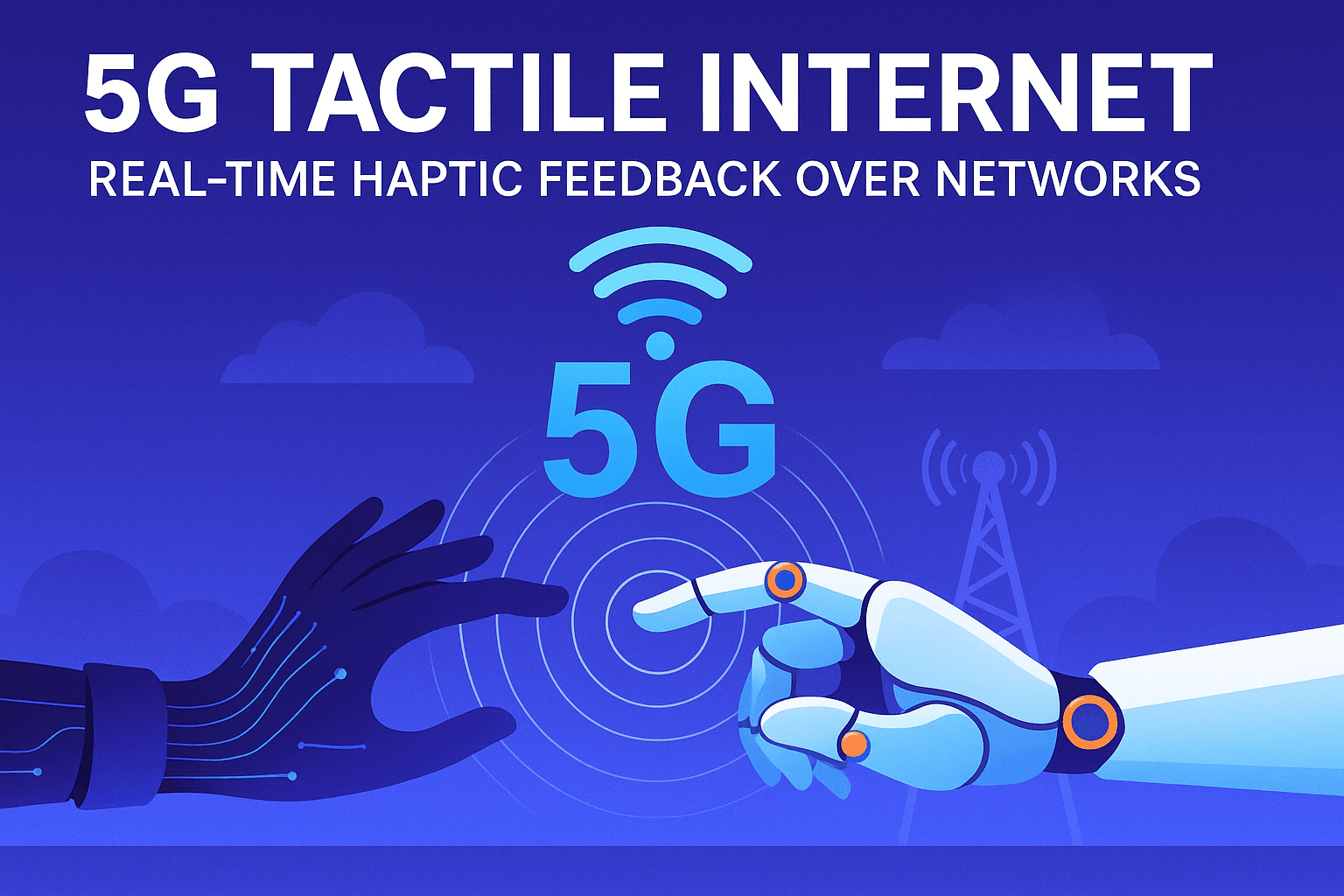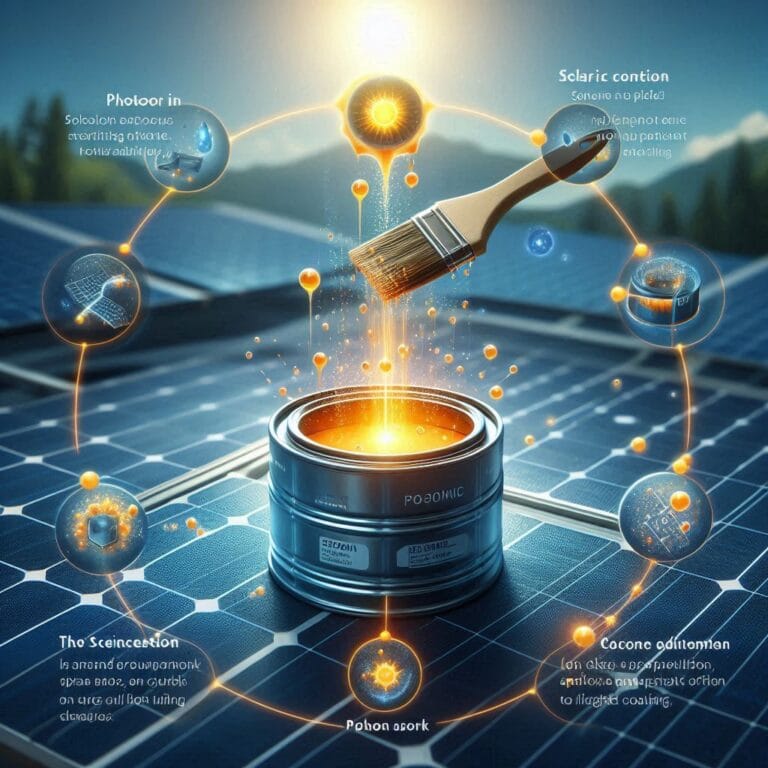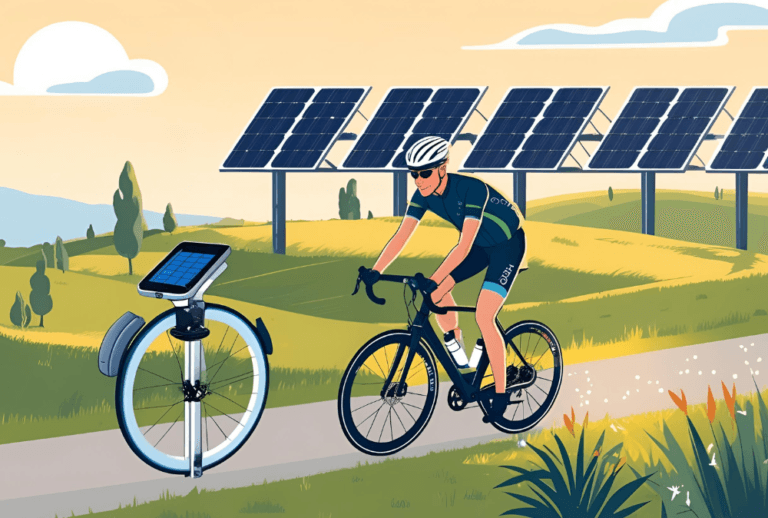Introduction
Imagine performing a complex surgical procedure or operating heavy machinery from thousands of miles away, feeling every movement as if you were physically present. This is not science fiction—this is the promise of the Tactile Internet.
The rise of the Tactile Internet marks a transformative milestone in the evolution of internet capabilities. Unlike previous generations focused solely on speed and data transmission, the Haptic Internet is designed to transmit touch and actuation in real time. This advancement brings a new dimension to remote interactions by enabling real-time haptic feedback, making users feel as if they are physically present in a distant environment.
At the heart of this technological evolution lies 5G Tactile Internet—a convergence of ultra-fast connectivity and ultra-low latency enabled by fifth-generation wireless technology. The 5G Tactile Internet facilitates near-instantaneous data exchange, which is crucial for transmitting touch-based interactions without perceptible delay. This opens the door to countless applications in healthcare, manufacturing, education, and beyond.

The Ultra-low Latency Internet isn’t just an upgrade; it’s a paradigm shift in how we interact with digital systems, blending the physical and virtual worlds like never before.
Understanding the Tactile Internet
To fully appreciate the impact of the Tactile Internet, it’s important to understand its fundamental principles and core technologies. At its essence, the Tactile Internet is a network capable of delivering ultra-low latency, high reliability, and real-time haptic feedback, which allows users to touch and control remote environments as if they were physically present.
This is made possible through a series of technological innovations, chief among them being 5G networks. Unlike 4G, which focused on enhancing mobile internet speeds, 5G introduces millisecond-level latency and unprecedented reliability—both of which are crucial for the Tactile Internet to function effectively. These capabilities ensure that tactile data (e.g., pressure, texture, vibration) can be transmitted and received with imperceptible delay, thereby creating seamless and lifelike interactions.
A central feature of the Ultra-low Latency Internet is haptic feedback, a technology that simulates the sense of touch through vibrations or motions. Already popular in gaming and virtual reality, haptic feedback becomes exponentially more powerful when combined with the speed and responsiveness of 5G Tactile Internet. This allows users not only to see and hear what’s happening remotely but also to feel it—transforming the digital experience into something truly immersive.
As a result, applications of the Tactile Internet span across remote robotic surgery, virtual training simulators, tele-operated construction equipment, and even remote education tools that allow students to interact with physical objects in real time. The role of haptic feedback in these scenarios is not just additive—it is transformative.
How 5G is Powering the Rise of the Tactile Internet
The vision of the Tactile Internet—where users can transmit touch, movement, and control signals in real time—was impossible to realize with previous generations of wireless networks. Traditional 3G and 4G technologies suffered from high latency, limited bandwidth, and inconsistent reliability, which made real-time haptic communication highly impractical. Even minor delays in transmitting tactile data could lead to unsafe or failed interactions in high-stakes applications like surgery or autonomous systems.
This is where the 5G Tactile Internet steps in. Built specifically to handle the demands of real-time, mission-critical communication, 5G network capabilities overcome the core limitations of earlier networks.
Key 5G Capabilities Empowering the Tactile Internet:
- Ultra-low latency: 5G offers latency as low as 1 millisecond—far faster than the 50-100 milliseconds typical of 4G. This negligible delay is crucial for enabling lifelike haptic feedback and instantaneous response in remote operations.
- Massive bandwidth: With significantly increased data throughput, 5G network capabilities support the seamless transmission of high-volume sensory data, including video, audio, and haptic signals simultaneously.
- High reliability: 5G networks are designed to be ultra-reliable, even in environments with massive device connectivity or high data demands. This ensures that real-time communications are consistent and uninterrupted.
These attributes make the 5G Tactile Internet a technological enabler for a new era of innovation.
Applications Now Possible Due to 5G-Enabled Tactile Internet:
- Remote robotic surgery where surgeons control robotic arms with the precision of in-person procedures.
- Teleoperation of hazardous machinery in industries like mining or nuclear power, enhancing worker safety.
- Virtual and augmented reality experiences that are indistinguishable from real-world interaction due to high-fidelity touch feedback.
- Remote education and training that allow students to interact with physical objects or lab equipment through haptic devices.
Without the advanced 5G network capabilities, these innovations would remain theoretical. Thanks to the 5G Tactile Internet, they are rapidly becoming reality.
Telesurgery: A Case Study in 5G Tactile Internet Applications
One of the most groundbreaking applications of the 5G Tactile Internet is telesurgery—the practice of performing surgical operations remotely using robotic systems and real-time communication technologies.
What is Telesurgery?
Telesurgery involves a surgeon operating a robotic surgical system from a distant location, often using a console that mirrors the actions in a remote operating room. This technology bridges the geographical divide, enabling expert medical professionals to perform procedures in regions that lack access to specialized surgical care.
The defining feature that sets telesurgery robot based on 5G Tactile Internet apart from earlier remote surgical systems is the integration of real-time haptic feedback. This allows the surgeon not only to see the surgical field but to feel tissue textures, resistance, and movement—making the procedure far more precise and responsive.

Why 5G is Critical for Telesurgery:
- Millisecond precision is vital in remote surgery—any slight delay can be the difference between success and disaster. With its ultra-low latency, 5G ensures surgical actions are mirrored instantaneously, eliminating noticeable lag and enhancing procedural safety.
- High bandwidth: Surgical robots transmit high-definition video, audio, and touch data simultaneously. The massive bandwidth provided by 5G network capabilities supports this data flow without interruption.
- Network reliability: Any drop in signal during a remote procedure could be catastrophic. 5G’s robust architecture ensures stable, uninterrupted connections that are essential for patient safety.
Real-World Examples of 5G-Enabled Telesurgery:
- In a groundbreaking 2019 demonstration, a Chinese brain surgeon successfully conducted the world’s first remote animal surgery using a 5G-powered telesurgery robot—bridging a distance of more than 3,000 km between surgeon and patient with real-time precision.
- South Korea and the U.S. have launched pilot programs exploring the feasibility of 5G-powered robotic surgery in rural hospitals and combat zones.
- Ericsson and King’s College London have demonstrated 5G-assisted haptic robotic surgeries during tech showcases, proving the feasibility of real-time control and feedback over long distances.
Telesurgery showcases how the 5G-powered Ultra-low Latency Internet can redefine the boundaries of modern medicine, enabling real-time, remote procedures with unprecedented precision. With further advancement and wider rollout of 5G network capabilities, the future of remote surgical care looks not only possible but promising.
Beyond Medicine: Industrial Applications of the Tactile Internet
While healthcare applications like telesurgery are among the most headline-grabbing, the Tactile Internet is poised to transform a wide array of industries. One of the most promising frontiers is in Tactile Internet industrial operations, where remote haptic feedback enables real-time control and interaction with physical systems located far from the user.
Remote Industrial Operations Powered by Real-Time Haptic Feedback
Imagine an engineer operating a crane on an offshore oil rig or a robotic arm inside a radioactive facility—all from a safe, distant control room. Thanks to remote haptic feedback, this is no longer a fantasy. Operators can now feel the resistance, vibrations, and fine movements of heavy machinery in real time, dramatically improving precision and control.

Real-World Industrial Applications
- Hazardous environment operations: The Tactile Internet allows human operators to control equipment in extreme or dangerous environments—such as deep-sea drilling rigs, chemical plants, or disaster zones—without physical risk.
- Precision manufacturing: Real-time remote haptic feedback enables fine-tuned control over complex manufacturing processes such as micro soldering, material testing, or automated assembly lines, where millimeter-level accuracy is required.
- Maintenance and diagnostics: Skilled technicians can remotely perform maintenance on machinery, feel component vibrations, or assess mechanical wear—all without being on-site.
Benefits in Industrial Settings
The adoption of Tactile Internet industrial operations brings a multitude of advantages:
- Improved safety standards: Human presence is minimized in hazardous or high-risk zones, reducing exposure to physical and chemical dangers.
- Increased efficiency: Real-time remote collaboration across time zones and regions reduces downtime and boosts productivity.
- Cost-effectiveness: Minimizing the need for on-site specialists reduces travel, equipment relocation, and staffing costs.
As 5G and edge computing become more widespread, remote haptic feedback will become an indispensable tool in industries ranging from construction and logistics to aerospace and energy.
Technical Challenges and Considerations
Despite its immense potential, the Tactile Internet is still in its early stages of development, facing several critical technical and infrastructural challenges. For the Haptic Internet to fulfill its promise, developers and network providers must address numerous issues, particularly in the areas of latency, reliability, and security.
Core Tactile Internet Challenges
- Ultra-low latency: Achieving sub-millisecond latency is essential for the real-time haptic feedback that the Tactile Internet relies on. Any delay can break the sense of immersion or even cause dangerous missteps in industrial or medical applications.
- High reliability: In mission-critical operations, a dropped signal or jitter can be catastrophic. Ensuring 99.999% uptime and data fidelity is one of the most pressing Tactile Internet challenges.
- Massive data rates: Haptic feedback data is dense and continuous. Transmitting this data—along with high-resolution audio and video streams—requires sophisticated data compression techniques and powerful processing capabilities.
5G Network Infrastructure Requirements
To support these demands, robust 5G network infrastructure is a must. However, challenges remain:
- Coverage gaps: In many parts of the world, full 5G coverage is still years away, limiting the scalability of Tactile Internet applications.
- Edge computing: To process data near the source and reduce transmission delays, advanced edge computing systems must be integrated into the 5G network infrastructure.
- Network slicing: This technique, which dedicates specific virtual segments of a network to different applications, is essential for guaranteeing performance, but it adds complexity to deployment.
Cybersecurity Considerations
With sensitive operations and data being transmitted in real time, cybersecurity becomes a critical issue. The Tactile Internet challenges include:
- Data integrity: Ensuring that haptic and control signals are not intercepted or altered en route.
- Privacy: Protecting user data and interactions, particularly in applications like telemedicine or military control systems.
- Resilience to attacks: Building systems that can withstand potential cyber threats, including denial-of-service attacks or sensor spoofing.
Successfully overcoming these Tactile Internet challenges will require coordinated global efforts in standardization, infrastructure investment, and secure system design. Only then can the 5G network infrastructure truly support the next generation of immersive, real-time internet experiences.
Ethical and Social Implications
As with any groundbreaking innovation, the rise of the Haptic Internet brings not only excitement but also a host of ethical and societal considerations that must be addressed thoughtfully. While the benefits of real-time haptic communication are immense, its widespread deployment raises complex questions about privacy, equity, and human interaction.
Key Ethical Concerns of the Tactile Internet
- Data privacy and consent: The transmission of real-time tactile data introduces new forms of sensitive information. Users interacting through touch-based systems must have clarity on how their data is collected, stored, and used. One of the pressing Tactile Internet ethics challenges is ensuring transparent consent mechanisms and robust data protection protocols.
- Job displacement and automation: As industries adopt remote operations and robotic systems, there is potential for job roles to be automated. While some roles will evolve or become more technical, others may be rendered obsolete, creating workforce displacement concerns.
- Informed use in high-risk fields: In sectors like healthcare or defense, the ethical use of haptic systems becomes even more critical. Clear guidelines are needed to determine who is accountable when decisions are made through remote systems.
The Digital Divide: A Growing Concern
Perhaps one of the most significant societal challenges tied to the Tactile Internet is the digital divide. Advanced applications that require 5G, edge computing, and sophisticated haptic devices may be inaccessible in low-income or rural communities, exacerbating existing inequalities.
Without equitable access:
- Communities may be excluded from advanced medical procedures, remote education, or industrial employment opportunities.
- Nations with underdeveloped digital infrastructure could fall further behind in economic competitiveness.
Addressing the digital divide will require coordinated global efforts in infrastructure investment, affordable device access, and inclusive policy-making.
Psychological and Social Impacts
As real-time haptic interaction becomes a substitute for physical presence, we must also consider the psychological impact. Over-reliance on remote touch and interaction may affect interpersonal relationships, mental health, and the nature of human connection. Ensuring that Tactile Internet ethics extend to emotional and cognitive well-being is essential as we move forward.
Future Prospects and Innovations
The Tactile Internet is just at the dawn of its evolution. As innovation accelerates, its ripple effects will redefine industries, reshape societies, and seamlessly integrate into our daily lives.
Ongoing Research and Breakthrough Technologies
Researchers and tech companies are exploring ways to enhance the future of Tactile Internet through:
- Next-gen haptic interfaces: Wearables, skin-integrated electronics, and neural sensors are being developed to improve tactile realism and immersion.
- AI and machine learning integration: Smart algorithms can predict user intent, adapt haptic responses, and optimize data transmission, making systems more intuitive and responsive.
- Quantum networking and 6G: While still in its infancy, quantum communication and ultra-fast 6G networks could drastically improve latency, security, and bandwidth beyond what 5G allows.
Expanding Applications
The future of Tactile Internet holds promise for:
- Remote education labs where students interact with physical models and equipment from home.
- Virtual tourism that allows people to “feel” textures, temperatures, and vibrations of distant locations.
- Remote mentorship in skilled trades, enabling experts to physically guide apprentices through tasks using real-time tactile feedback.
Investing in the Future
To fully unlock the benefits of emerging technologies, continued investment in:
- Infrastructure like 5G and edge data centers,
- Education in STEM fields, haptics, and robotics,
- and Policy innovation for ethical frameworks and standards
…is critical for a sustainable and inclusive future of Tactile Internet development.
Conclusion
The Tactile Internet, powered by the capabilities of 5G, represents a bold new chapter in digital evolution—one where sight, sound, and touch converge to create seamless, immersive, and responsive experiences. From telesurgery and remote industrial control to education and entertainment, the potential applications of real-time haptic feedback are vast and transformative.
However, this revolution is not without its challenges. As we advance toward widespread adoption, we must confront ethical dilemmas, bridge the digital divide, and build resilient infrastructure to ensure the technology benefits everyone.
Now is the time for technologists, policymakers, educators, and citizens alike to stay informed and actively shape how the Tactile Internet evolves. Whether you’re in healthcare, manufacturing, education, or entertainment, understanding these developments will empower you to innovate and adapt in a world increasingly shaped by the real-time touch of the internet.
Explore More on the Evolution of Communication Technologies
If you’re fascinated by the tactile capabilities of 5G, don’t miss these related articles that trace the journey and innovations behind modern connectivity:
-
📡 Terahertz Communication & 6G: The Future of Wireless Tech – Discover the ultra-high frequencies shaping the next wave beyond 5G.
-
🌊 How Does Sonar Work? History, Science, and Applications – Dive into the world of underwater sound navigation and its real-world uses.
-
☎️ Invention of the Telephone – Revisit the groundbreaking invention that revolutionized voice communication.
-
📨 The Fascinating Invention of Telegraph – Learn how the telegraph laid the foundation for real-time global communication.






